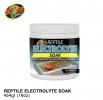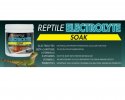Any thoughts on ZooMed's electrolyte soak product? I might consider buying it so that my tort becomes more hydrated since she barely to never drinks in her soaks so I was wondering if anyone on the forum has ever used this product
You are using an out of date browser. It may not display this or other websites correctly.
You should upgrade or use an alternative browser.
You should upgrade or use an alternative browser.
Zoo Med Electrolyte Soak
- Thread starter Justincl
- Start date
I would compare the ingredients to Pedialyte and Carrot puree baby food. If it is the same you could probably buy both cheaper. Also daily soaks allow the tort to take in moisture without drinking keep the faith and keep soaking. BTW I have both Pedialyte and Carrot puree on my shelf at home for a just in case or emergency situation. Never hurts to be prepared!
Carrots are a good source of several vitamins and minerals, especially biotin, potassium, and vitamins A (from beta carotene), K1 (phylloquinone), and B6.
- Vitamin A: Carrots are rich in beta carotene, which your body converts into vitamin A. This nutrient promotes good vision and is important for growth, development, and immune function (15Trusted Source).
- Biotin: A B vitamin formerly known as vitamin H, biotin plays an important role in fat and protein metabolism (16Trusted Source).
- Vitamin K1: Also known as phylloquinone, vitamin K1 is important for blood coagulation and can promote bone health (17Trusted Source, 18Trusted Source).
- Potassium: An essential mineral, potassium is important for blood pressure control.
- Vitamin B6: A group of related vitamins, B6 is involved in the conversion of food into energy.
The Reptile Soak contains Citric Acid and prebiotics which makes me go hmm. Citric Acid is a preservative but it does help break down bacteria and viruses.
I've used baby food cut 50:50 with warm water with a very dehydrated Hingeback rescue... I placed the tort and the soaking chamber in their enclosure to keep it at temperature for really long soaks (6-10 hours) every day.
I used organic baby food, carrot or carrot/mango/sweet-potato....
Jamie
I used organic baby food, carrot or carrot/mango/sweet-potato....
Jamie
ZenHerper
Well-Known Member
Electrolytes, like many nutrients, can be overdosed. Salts, minerals, etc., are not for everyday supplementation in reptiles (they don't sweat).
If an animal is experiencing an acute problem with dehydration, nutrient-poor diet, or has to be maintained on distilled water, this type of preparation can be helpful for a short time. Otherwise it can cause more harm than good.
Make sure that clean, natural water is available at all times. Feed a wide variety of fresh greens (you can sprinkle them with water as well). Monitor the quality of urine and any excreted urates.
If an animal is experiencing an acute problem with dehydration, nutrient-poor diet, or has to be maintained on distilled water, this type of preparation can be helpful for a short time. Otherwise it can cause more harm than good.
Make sure that clean, natural water is available at all times. Feed a wide variety of fresh greens (you can sprinkle them with water as well). Monitor the quality of urine and any excreted urates.
Thanks for the info guys really appreciate it! I'll most likely just use it once in a month or so since the water I have is RO water but i usualky mix a bit of mineral water in it. For now i do in fact see daily pees in the evening but I still have to fix my sulcata's partially gritty pasty urates since she's barely drinking from ber water dish and soaks so I compensate by feeding a bit of lettuce after her fiber meal. I've had her since september 2020 but i barely see any growth so im considering that her previous bladder stone might be the cause. Her diet includes mulberry leaves, hibiscus leaves, siomak (a type of veggie high in fiber), opuntia cactus, aloe (very occasional), freshly cut eheatgrass and some mazuri LS pellets once in a week
I'm assuming that she might not be drinking because her nose might be clogged a bit with some clear sticky liquid. For now im using an electrical aspirator to suck some of the liquid inside her nose but on the lowest suction level and i'm administering some antibiotics orally and raising her enclosure temps
ZenHerper
Well-Known Member
Proper temps will do much more than antibiotics. Reptiles have not spent enough generations in captivity to adjust to different climates from the ones they live in naturally. Husbandry must by 100% certain.
Instead of RO + bottled mineral water, use plain bottled drinking water from a food store. It will be very hard to replicate the chemistry of plain clean drinking water, and errors in trying may be interfering with your pet's kidney functions. If your mix is too "heavy" in salts and minerals, the kidneys will start sending water molecules back into the blood, and generating more urate clumps from metabolized proteins.
Instead of RO + bottled mineral water, use plain bottled drinking water from a food store. It will be very hard to replicate the chemistry of plain clean drinking water, and errors in trying may be interfering with your pet's kidney functions. If your mix is too "heavy" in salts and minerals, the kidneys will start sending water molecules back into the blood, and generating more urate clumps from metabolized proteins.
Understood will do thx for the advice ?Proper temps will do much more than antibiotics. Reptiles have not spent enough generations in captivity to adjust to different climates from the ones they live in naturally. Husbandry must by 100% certain.
Instead of RO + bottled mineral water, use plain bottled drinking water from a food store. It will be very hard to replicate the chemistry of plain clean drinking water, and errors in trying may be interfering with your pet's kidney functions. If your mix is too "heavy" in salts and minerals, the kidneys will start sending water molecules back into the blood, and generating more urate clumps from metabolized proteins.
Most people in the entire world do not start this species correctly, and most buyers have the wrong ideas about housing them. I find that people in tropical countries especially think they don't need indoor chambers with heat lamps and such. They do. Housing this species in open topped enclosures or outside all day just does not work well any where in the world. The urates you've seen are just one indication of this fact, and the lack of growth is another.Thanks for the info guys really appreciate it! I'll most likely just use it once in a month or so since the water I have is RO water but i usualky mix a bit of mineral water in it. For now i do in fact see daily pees in the evening but I still have to fix my sulcata's partially gritty pasty urates since she's barely drinking from ber water dish and soaks so I compensate by feeding a bit of lettuce after her fiber meal. I've had her since september 2020 but i barely see any growth so im considering that her previous bladder stone might be the cause. Her diet includes mulberry leaves, hibiscus leaves, siomak (a type of veggie high in fiber), opuntia cactus, aloe (very occasional), freshly cut eheatgrass and some mazuri LS pellets once in a week
Your diet sounds great.
The respiratory infection is likely due to cold damp night temps and the lack of night heat. More heat is the cure. Keep the temp 29-32C all the time using a heat source set on a thermostat, and offer a 36-37C basking area for 12-13 hours of every day. Its all explained here:I'm assuming that she might not be drinking because her nose might be clogged a bit with some clear sticky liquid. For now im using an electrical aspirator to suck some of the liquid inside her nose but on the lowest suction level and i'm administering some antibiotics orally and raising her enclosure temps
The Best Way To Raise A Sulcata, Leopard, Or Star Tortoise
I chose the title of this care sheet very carefully. Are there other ways to raise babies? Yes. Yes there are, but those ways are not as good. What follows is the BEST way, according to 30 years of research and experimentation with hundreds of babies of many species. Babies hatch during the...
Will do Tom appreciate it ?Most people in the entire world do not start this species correctly, and most buyers have the wrong ideas about housing them. I find that people in tropical countries especially think they don't need indoor chambers with heat lamps and such. They do. Housing this species in open topped enclosures or outside all day just does not work well any where in the world. The urates you've seen are just one indication of this fact, and the lack of growth is another.
Your diet sounds great.
The respiratory infection is likely due to cold damp night temps and the lack of night heat. More heat is the cure. Keep the temp 29-32C all the time using a heat source set on a thermostat, and offer a 36-37C basking area for 12-13 hours of every day. Its all explained here:
The Best Way To Raise A Sulcata, Leopard, Or Star Tortoise
I chose the title of this care sheet very carefully. Are there other ways to raise babies? Yes. Yes there are, but those ways are not as good. What follows is the BEST way, according to 30 years of research and experimentation with hundreds of babies of many species. Babies hatch during the...tortoiseforum.org
Similar threads
- Replies
- 10
- Views
- 1K
New Posts
-
-
-
-
-
Setting up for a Russian Tortoise - Constructive comments welcome
- Latest: David Steere

